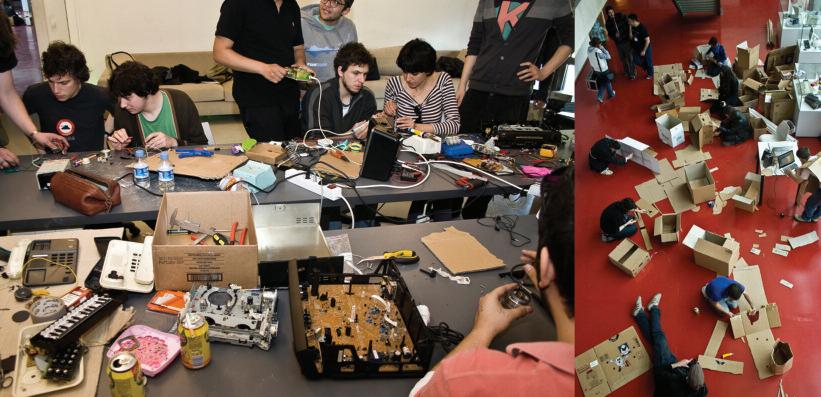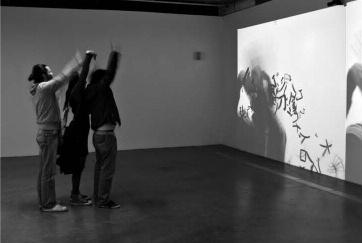
10 minute read
COVER STORY Extension Division opens a branch of American Ballet Theatre ’ s Jacqueline Kennedy Onassis School Children ’ s Division
American Ballet Theatre ’ s Jacqueline Kennedy Onassis School Children ’ s Division opens satellite at Mason Gross
he Mason Gross Extension Division has partnered with the acclaimed American Ballet Theatre to open a satellite branch of their Jacqueline Kennedy Onassis School Children ’ s Division.
Advertisement
Barbara Bashaw, graduate director of the EdM program in Dance Education at Mason Gross, says the JKO school not only provides rigorous training, it exposes young
dancers “to a vast repertoire of classics, internationally acclaimed performers as role models and the opportunity to become a part of ballet culture, not just ballet classes. ”
Ideally, says Christopher Kenniff, director of the Extension Division, “The classes initiate a lifelong relationship with the art form. Success, ultimately, is about immersing in the whole art form as opposed to merely mastering the craft. ”
Mason Gross Dean George B. Stauffer says the alliance benefits the school’ s Dance Department, as well as the JKO program ’ s participants.
“We have wanted to strengthen and expand the ballet component of our Dance program for some time, and our newly forged alliance with American Ballet Theatre gives us the opportunity to accomplish this goal, ” the Dean says. “ABT is one of the most distinguished dance companies in the nation, both in terms of performance and educational outreach. Our students will benefit immensely from our collaboration with this magnificent troupe. ”
According to ABT, the ABT/JKO school’ s National Training Curriculum was created in partnership with a medical advisory board. The curriculum features age-appropriate, outcome-based guidelines and incorporates elements of the French, Italian and Russian schools of ballet.
Bashaw says ABT’ s curriculum and accredited instructors “ put the well-being of children center stage and challenge the notion of professionalism in ballet instruction as mean-spirited and severe. ” ABT says classes focus on building a solid foundation in ballet technique with an emphasis on proper placement and safe progressions of movement.
And, in the end, the classes can offer children a means of expression and a vehicle for their imaginations.
“Many children are content to read the storybook classics; others prefer to live inside them, ” Bashaw says. “ABT allows them to do just that. ” —CK
T


Fallclassschedule
Pre-primary (ages 4-5): Saturdays, 9-9:45 a.m. Primary A (ages 5+): Saturdays, 10-11 a.m. Primary C (ages 7+): Saturdays, 11:15 a.m. -12:15 p.m. Level 1A (ages 9+): Saturdays, 1-2:30 p.m. and Mondays 6-7:30 p.m.
Primary classes are open to all; no prior experience is necessary Special registration discount: $100 off of fall 2012 semester for all registrants Rolling admission throughout the semester
732-932-8618 extension@masongross.rutgers.edu
STUDENT PROFILE: Kyle G. Marsh
BRUNO CHARBIT
As a child, Kyle G. Marsh struggled with dyslexia. But when she began studying dance at age 13, she says she realized that “there is a nonverbal expression that can be found through movement and dance that makes intrinsic sense to me. ” In 2014, Marsh is set to earn her Master of Education degree in Dance Education. The five-year joint BFA/EdM degree in Dance Education leads to pre-K-12 dance teacher certification, making it the only program in the country that links BFA degree major requirements to a master ’ s-level degree in dance education and dance-teacher certification. Here are some of Marsh’ s thoughts on the program, on helping students to express themselves via movement, and on getting inspired.

Why did you choose the EdM at Mason Gross?
I believe that because every human has a body, we all have a basic human right to better understand ourselves through moving and dancing. We tend to separate the intellectual from the physical and fail to recognize that different people learn in different ways. How has the EdM program changed you as a dancer? The BFA program at Mason Gross not only strengthened and challenged me but almost single-handedly turned me into a real pre-professional dancer. Dancing at Mason Gross has helped me organize a lot of the raw material that I had in my body into something tangible that I know how to use and access. Who has inspired you as a dancer and a teacher?
One of my most inspirational and influential teachers was a woman named Kay Fulton. She didn ’t want us being robots who just knew how to move our legs and arms; she also wanted us to understand where the movements came from.
She wanted us to develop an internal commentary for ourselves as dancers and performers. She wanted our bodies to be just as strong as our minds, and vice versa. As a teacher, I think I am currently most inspired by those who care. I am also inspired by anyone who teaches and is wise enough to understand that you must be willing to learn just as much from your students as they are willing to learn from you. Why do you want to teach? I’ m inspired by the openness and creativity of young people. It brings a smile to my face when I am able to experience and see a child or young person express himself or herself through art. I believe it’ s a basic human right to have access to this type of expression, and through teaching can only hope to make this medium more accessible to more people. —LG
Catch Marsh’s choreography along with that of student Carlo Antonio Villanueva in a free performance at 6 p.m. Oct. 14 at Loree Dance Theater. The event also will feature the Rutgers Center For Digital Filmmaking’s original documentary on Israeli choreographer Danielle Agami’s collaboration with Mason Gross dancers and choreography by Inbal Pinto. Learn more about the EdM Dance Education program by visiting www.masongross.rutgers.edu/dance.
IN MEMORIAM: Claudia Gitelman, Dance
Claudia Gitelman, professor emerita of Dance, died at her home in New York City on Tuesday, Aug. 7, 2012.
The artist and scholar, aka “Golden Claudia, ” served as an associate professor of Dance at the Mason Gross School of the Arts from 1985 to 1998. She authored the book Dancing With Principle: Hanya Holm in Colorado, 1941-1983 and was long associated with Holm. Gitelman danced internationally, on Broadway and as an original member of Nikolais Dance Theatre.
Gitelman ’ s choreographic work Inside Sam was just performed at the American Dance Guild Festival on Sept. 8, 2012, at the Alvin Ailey Citigroup Theater in New York City.
In lieu of flowers, donations in Gitelman ' s name may be made to the New York Public Library by visiting www.nypl.org/support and clicking on “Honor and Memorial Gifts. ” At the very bottom of the form, please specify that your donation go specifically to the Library for the Performing Arts, where Gitelman spent many hours.

LARRY LEVANTI
Paulette Sears, from left, Claudia Gitelman, Pat Mayer and Julia Ritter in December 2011 at a reception for the Dance Department’ s 30th anniversary.


Turkish media artist finds new home at Mason Gross
Editor ' s Note: The following story is courtesy of Rutgers Today and Sherrie Negrea
When he was growing up in Ankara, Turkey, Ahmet Atif Akin dreamed of becoming a photographer. By the time he was 16, he had a darkroom and had submitted his photographs to group shows. Yet he ended up earning degrees in chemical engineering and industrial design because that was the best education he thought Turkey could offer him.
After completing a master ' s degree from the Middle East Technical University in Ankara in 2005, Akin parlayed his technical training into a career in electronic art. He exhibited his digital designs in online galleries around the world, collaborating with artists in Europe and the United States. His work quickly attracted recognition, and in 2009, he was listed as one of the 500 best artists under 33 years of age fromaroundworld in the Younger Than Jesus: Artist Directory, published by the New Museum in New York. In September 2011, Akin joined the faculty at the Mason Gross School as an assistant professor in the Visual Arts Department. A former instructor of new media and design at Bilgi University and Kadir Has University in Istanbul, Akin was selected for the position after an international search for an artist specializing in digital design. "He ' s an example of someone who can come from Istanbul and bring a different perspective, and yet there ' s an irony to that, " says Gerry Beegan, an associate professor of design and undergraduate director of the visual arts department. "Everyone is using the same tools and the same software and the same hardware in what he does. So he ' s international, yet he brings something fresh. "
In his studio class on interactive design, Akin has found that teaching offers him a different way of expressing himself that is even more rewarding than creating art. "Trying to make a concrete statement to a group of people and trying to justify your statement with specific examples–sometimes I find that more interesting than doing my own artwork, " he says.
Just as engineering introduced Akin to abstract thinking and how to define–and not just solve–a problem, the Internet introduced him to new forms of media art. While a graduate student in Ankara, he followed online galleries and their artists, and became more interested in new media than in photography.
He began producing videos, multimedia installations and photography projects. In 2009, he founded and organized the PixellST festival in Istanbul, dedicated to the electronic arts and its subcultures. He also started working with xurban.net, an international art collective that examines contemporary politics.
As an artist in Turkey, Akin says he never experienced repression of his work, yet because he felt that "freedom is quite questionable, " he chose not to show his art frequently in his native country. "The media of expression is controlled, " he says. "There is always the issue of censorship. You never really feel free to do what you want. "
One video installation he created in Istanbul directly questioned the Turkish government in its role in reacting to the recurring earthquakes that have killed thousands of people and destroyed hundreds of buildings across the country. In 2008, a high-rise hotel in the center of Istanbul commissioned Akin to produce an installation on the video screen that sits atop its roof. Calling the work Evacuate Istanbul! Akin used current data from a Turkish earthquake observatory center to announce, in a constantly running, multicolored video stream, tremors being recorded in towns throughout the country.
"That was a political statement, " Akin says. "I got multiple reactions from different types of people. They felt it was a project urging the government to take precautions. "
Much of his artwork bridges cultures and time periods. At an exhibit at Rutgers in fall 2011, Akin displayed some photographs of a market in Odessa, Ukraine, known for selling fabrics from Turkey. Akin took the photographs, depicting the market stalls in shades of gray, gold, pink, and blue, while visiting Chernobyl, where he is working on a project taking pictures of the region ' s abandoned villages.
Now living in Jersey City, Akin finds the artistic life in the New York area to be vibrant and full of possibilities for collaboration with other digital artists. "The first thing I can do is find a subculture that I feel that I belong in, " he says. "There is space for me in the subculture and for people like me so we can share our views and discuss these issues. " —SN
MATT RAINEY


COURTESY AHMET ATIF AKIN
Clockwise from above left, Akin with a student; snapshots from the exhibit Uncharted, which Akin curated, and snapshots from another Akin-curated event, Pixielist.







